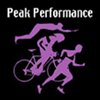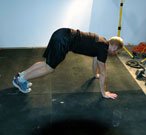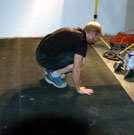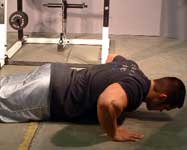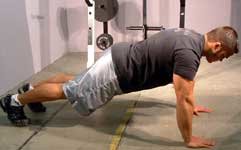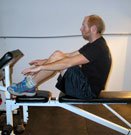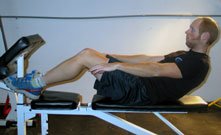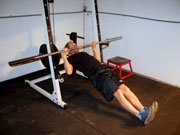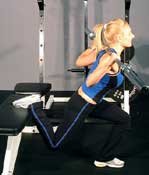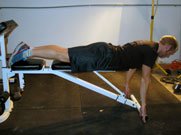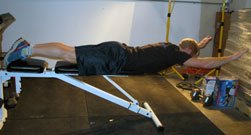These exercises are an excellent way to build strength and stamina simultaneously. During the past few years, endurance athletes in a number of sports have added resistance exercises to their training programmes in an effort to boost their muscle power and decrease their risk of injury.
Scientific studies have linked resistance training with a reduced rate of injury in athletes, probably because resistance work fortifies leg muscles and strengthens 'weak links' in athletes' bodies, including the often-injured hamstrings and shin muscles, as well as abdominal and low-back muscles.
 |
||||
 |
|
 |
||
 |
||||
Resistance work can also improve tendon and ligament strength and increase bone density, effects which should help to lower injury rates. In addition, resistance workouts heighten body awareness, upgrade coordination, reduce body-fat levels, and improve self esteem, all of which can contribute to improved performance during competition.
For athletes, the general preparation period before the beginning of actual competitions is an ideal time to initiate a resistance training programme. A four- to eight-week period of sound resistance training helps to develop a nice foundation of suppleness (mobility), strength, and stamina (endurance), to which athletes can add speed and racing skill just before the competitive season begins.
 'Circuit training' is an excellent way to simultaneously build strength and stamina. The circuit-training format utilises a group of strength exercises (usually six to 10 or more) that are completed sequentially (one exercise after another). Each exercise is performed for a specified number of repetitions or for a prescribed time period before moving on to the next exercise.
'Circuit training' is an excellent way to simultaneously build strength and stamina. The circuit-training format utilises a group of strength exercises (usually six to 10 or more) that are completed sequentially (one exercise after another). Each exercise is performed for a specified number of repetitions or for a prescribed time period before moving on to the next exercise.
The exercises within each circuit are separated by brief, timed rest intervals, and each circuit is separated by a longer rest period. The total number of circuits performed during a training session may vary from two to six depending on your training level (beginner, intermediate, or advanced), your period of training (preparation or competition), and your primary training objective (You may be developing total work capacity, boosting your power, or engaging in 'active rest,' for example.)
I have designed this special circuit-training programme with the following objectives in mind:
- The circuit work will increase your general work capacity by improving your ability to tolerate increasing levels of muscular fatigue (stamina improvement).
- Over time, the circuit training will have shorter and shorter rest intervals between exercises, thus maintaining elevated heart rates during the circuit workouts and helping you to upgrade your cardiorespiratory capacity (stamina improvement).
- Circuit efforts will enhance your overall body strength, including the strength and resiliency of muscles, tendons, and ligaments, the integrity of your joints, and the strength and density of your supporting bone structures (strength improvement).
- The circuits will improve your movement skill and body awareness, because you'll perform exercises that utilise body weight as the primary form of resistance (skill improvement).
- The circuit programme will increase your lean muscle mass by a moderate amount and decrease your body-fat levels through high levels of energy expenditure (body composition improvement).

The Basic Training Circuit: Recommendations

 |
||||
 |
|
 |
||
 |
||||
Your basic training circuit can easily be combined with the mobility training described in the March 1995 issue of Peak Performance to form a well-rounded training session. A full mobility-plus-circuit workout, including warm-up, mobility training, circuit work, and a 10-minute cool-down can be completed in about an hour or less. Is that too much time for the busy athlete? Definitely not!
For one thing, you only need to complete the overall workout twice weekly during your base conditioning period. In addition, the payoffs from circuit training are great. Whether you're a cyclist, a racewalker, a runner, a rugby player, a swimmer, or a participant in racket sports, you'll improve your strength, mobility and stamina through circuit training.
As a result, you will move much more powerfully as you take part in your sport. Bear in mind, though, that for best results the circuit training sessions should not be performed on consecutive days. If you are carrying out other intensive training on the same day as the circuit work, do the intensive work before the circuit training, since fatigue levels from the circuit might well interfere with training intended to develop speed, power, or event-specific endurance.
Better yet, carry out circuit training on days during which other training is of low intensity. Don't do your circuit training on a rest day, however; rest really means rest!
Here is your sequential format for each circuit:
- Total-body exercise
- Upper-body exercise
- Lower-body exercise
- Core/trunk exercise
- Total-body exercise
- Upper-body exercise
- Lower-body exercise
- Core/trunk exercise
Notice that each part of the body is emphasised twice during each circuit.

Circuit Exercises

For each circuit, do the following exercises:

Four-count Squat Thrusts

Four-count squat thrusts: Stand with your arms held at your sides, and then squat down, placing both hands in front of you on the floor. With arms straight and your weight resting on both hands, quickly extend both legs backward (hop backward), ending in a front-support position. Return legs forward (hop forward), ending in a low-squat position with hands on the floor.
Finally, jump into the air and return to a standing position. Repeat each of these four steps, in order, to a rhythmic 1-2-3-4 count, without pausing between counts or repetitions.
 Benefits
Benefits
The high degree of amplitude (joint motion) at your hips and knees, combined with the resistance provided by your body weight, will develop strength and mobility in your knee and hip joints - important for high-speed movement.
The front-support position develops stability and strength in the upper trunk, abdominal, and pelvic regions, strength that is necessary to control torso movements during the running stride or when you strike a ball.
The jump added to the exercise as you return to a standing position greatly increases your cardiac demand, hikes the power of your leg muscles, and increases the impact forces (upon landing) as well, fortifying the bones in your legs and feet. Use caution, though; perform the movements on a gym floor or grass, not on concrete.

Push-ups

Push-ups: Start in the front-support position with your hands and toes on the floor and trunk, hips, and legs extended. Bend your arms and lower your chest to the floor. Then push your body upward as you straighten your arms, returning to the front-support position. Repeat this action rhythmically and continuously without stopping for the allotted time.
 Benefits
Benefits
Push-ups are well known for increasing upper-body strength, but their value in developing abdominal and hip-flexor stability is often ignored. This improved stability helps to control hip, trunk, and shoulder movements as you move quickly and also promotes balance between the upper and lower body.

Scissor Step-ups

Scissor step-ups: Use a step or bench which is approximately mid-shin to knee height. Put your left foot on the step, with your right foot on the floor and your arms at your sides. Then push down with your left leg and drive your body upward rapidly, switching support (hopping) from left foot to right foot as your body reaches its maximal vertical height.
With your right foot supporting your body, lower the left foot to the floor rapidly but under control. Repeat this action continuously, back and forth from foot to foot, without pausing at the top or bottom positions.
 Benefits
Benefits
The scissor step-up develops leg strength, power, and dynamic-balance control (coordination), without which you can't move quickly, whether it's from one end of the football pitch to the other, from the baseline to the net on a tennis court, or from the start to the finish of a 10k race.
Cardiovascular benefits of this exercise can be increased by speeding up your stepping cadence or by increasing the height of the step. Step heightening also enhances leg-muscle power and improves mobility of the hip and knee joints.

Abdominal Sit-backs

Abdominal sit-backs: For this exercise, use a step, bench, or chair which does not have a vertical, support for your back. Sit with your legs bent and your arms extended in front of you, and then recline your trunk backward at the hips by about 45 degrees. That's your starting point for the exercise. To do the sit-backs, raise both arms simultaneously overhead while maintaining tight abdominal muscles and a straight chest.
Then simply return your arms to the extended position in front of you, without moving your trunk or legs. Repeat this back-and-forth arm action in a smooth, continuous fashion without pausing at any point during the movement.
 Benefits
Benefits
The increased abdominal stability gained from sit-backs carries over to improved posture and better core stability as you run.
A strong pelvic girdle and trunk provide the anchor point for a strong pair of legs, allowing you to use your legs in a maximally powerful manner during quick sprints - or during sustained, vigorous running.

Squats To Presses

Squats to presses Use two dumbbells, each weighing approximately 10% of your body weight (e.g., if you weigh 150 pounds, each dumbbell should be 15 pounds). Individuals with less strength training experience may start with dumbbells which weigh 5% of body weight, while stronger athletes can use dumbbells checking in at 20% of body weight.
You may need to experiment a bit, using a weight that makes the exercise challenging but achievable. If dumbbells are unavailable, a barbell of comparable total weight can be utilised. To do the exercise, stand upright with your feet spaced about hip- to shoulder-width apart and your hands supporting the dumbbells in front of your shoulders.
Squat down until your thighs form an angle of 90 degrees with your shins (a half-squat), while maintaining a reasonably upright posture with your torso and while keeping your hands in front of your shoulders. Then rise quickly from the squat position while pressing (pushing) the dumbbells overhead simultaneously. Both arms and legs should reach full extension at the same time (You'll end up standing tall with legs straight and arms straight overhead).
Then lower the dumbbells in a controlled fashion to the starting position. Repeat this three-count movement smoothly and continuously.
 Benefits
Benefits
Squats to presses increase strength and power in your legs, hips, low back, abdominals, shoulders, and arms.
Note that the whole-body involvement of the squat to press increases your cardiorespiratory requirements, compared to the more commonly used, isolated pressing exercises such as bench and shoulder presses.

Body-weight Rows

Body-weight rows: For this one, you'll need a horizontal bar or beam which is sturdy enough to support your body weight. Set the bar at approximately the height of your navel (when you're standing straight up). To start the exercise, grip the bar with both hands at slightly wider than shoulder width, and hold your body in support underneath the bar.
Your heels should be on the floor, and your body should be straight and rigid from your shoulders to your ankles. Then, with your feet acting as a fulcrum, pull your chest up to the bar by bending your elbows and pulling them backwards. Return to the starting position by straightening your arms in a controlled manner, and repeat the overall action for the time period specified in the chart.
 Benefits
Benefits
The body-weight row does for the back side of the body what the push-up does for the front side. Body-weight rows improve pulling strength of the upper-back, shoulder, and arm muscles, but they also serve to increase stabilising strength in the low back, gluteals, and hamstrings, all of which are critically important for quick movement whenever you participate in your sport.
You'll achieve a balance between lower and upper body strength by performing this exercise.

One-leg Squats

One-leg Squats: You'll need a bench or step six to eight inches in height. Stand with your left foot flat on the floor and your right foot behind you and elevated on the step. The distance between your feet should be approximately the length of your shin, and most of your weight should rest on the heel of your left foot.
To do the exercise, bend your left knee and lower your body until the left knee makes an angle of 90 degrees between the thigh and lower leg. Return to the starting position by straightening your left leg, while maintaining an upright posture with your trunk. Repeat this action with the left leg for the specified amount of time, and then switch to the right leg.
 |
View Videos Of One-leg Squats! |
| ( Windows Media | Real Player ) |
 Benefits
Benefits
This exercise develops muscle strength in the quads, hamstrings, and gluteals, the muscles which provide much of your power while running. The actual motion of the one-leg squat closely resembles the 'frontside' mechanics of the hip and knee during the actual running stride.
By strengthening your hip and knee joints in a coordinated and integrated fashion, your leg strength and running power should improve tremendously. One-leg squats can also help you improve your vertical jumping ability.

Low-back Stabilisers

Low-back stabilisers: For this exercise, you'll need a bench, padded table, or 'Roman-Chair' bench. Lie face down with your body extended and your hips at the edge of the supporting surface of the bench. Your arms should be extended straight down toward the floor in front of you. For added stability, it helps if your feet are wedged between the end of the bench and a wall.
Smoothly raise both arms over your head simultaneously while maintaining your trunk in full extension (your body should be horizontal to the floor and held straight as an arrow), and then return both arms to the starting position. Repeat this action over and over again for the prescribed time period.
 Benefits
Benefits
Heightened low-back strength provides for proper posture while running and also provides excellent 'motion control' of the torso and hips throughout the running stride. As a result, you'll move more quickly - whether it's to return a serve on the tennis court or to reach the football in time to score a goal.
Remember that improvements in how your body functions can occur whenever you overload your body's systems. This circuit programme provides an overload of your cardiorespiratory system (especially the hard circuits), taxes your muscular system by forcing it to work against increased resistance, and forces the key joints involved in moving your body to go through a wider range of motion than they commonly encounter. The result, I believe, will be better, more powerful performances.
Walt Reynolds
